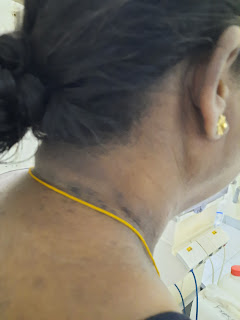Bimonthly assessment- october
https://swathibogari158.blogspot.com/2020/09/chronic-decompensated-liver-disease.html
1.Cause of ascites
Cirrhosis with Portal hypertension
The accumulation of ascitic fluid represents a state of total-body sodium and water excess
Hypoalbuminemia and reduced plasma oncotic pressure favor the extravasation of fluid from the plasma to the peritoneal fluid.

2. The relationship between cellulitis and lymphoedema appears to be
a vicious cycle; a pre-existing lymphatic
defect predisposes to cellulitis, episodes
of cellulitis damage the lymphatic system.
lymphoedema predispose to recurrent
episodes of cellulitis.
Repeated episodes of cellulitis are common with lymphedema.
Cellulitis is a bacterial infection of the deeper layers of skin and the fat and soft tissue layers under the skin.
https://www.ncbi.nlm.nih.gov/pmc/articles/PMC2804019/
3. https://jnnp.bmj.com/content/63/3/279
https://www.ncbi.nlm.nih.gov/pmc/articles/PMC2804019/
3. https://jnnp.bmj.com/content/63/3/279
Asterixis or “liver flap” and constructional apraxia are often present in the early stages of hepatic encephalopathy.
Asterixis consists of infrequent involuntary flexion-extension movements of the hand (one flap every one to two seconds), which may result in part from an impairment of the normal inflow of joint position sense to the brain stem reticular formation.
https://pmj.bmj.com/content/87/1031/605
Increased ammonialevels leads to lactate accumulation in the brain ➡️ microglial activation ➡️ increased levels of pro inflammatory cytokines and neuroinflammation ➡️ encephalopathy.
Lactose syrup reduces the intestinal absorption of ammonia . It reduces the ph of colonic content and prevents absorption of ammonia
https://images.app.goo.gl/FuVddJ18AssTr49P9
4.Rifaximin
https://www.researchgate.net/publication/327934281_Rifaximin_has_the_potential_to_prevent_complications_of_cirrhosis
Of patients receiving rifaximin (n = 140) and placebo (n = 159), 53.6% and 49.1%,
respectively, had baseline Model for End-Stage Liver Disease (MELD) score ⩾ 12 and
international normalized ratio (INR) ⩾ 1.2. Baseline ascites was observed in 36.4% (rifaximin)
and 34.6% (placebo) of patients. In patients with MELD score ⩾ 12 and INR ⩾ 1.2, rifaximin
reduced the relative risk (RR) of any first complication experienced during trial by 59% [hazard
ratio (HR) = 0.41, 95% confidence interval (CI): 0.25–0.67; p < 0.001] versus placebo. For
patients with baseline ascites, rifaximin reduced the RR of any first complication experienced
during trial by 42% versus placebo (HR = 0.58, 95% CI: 0.34–1.0; p = 0.045). For some
subgroups, there was a decrease in RR of complications of SBP, variceal bleeding, and acute
kidney injury/hepatorenal syndrome with rifaximin versus placebo, although there were few
events reported in the study.
Conclusion: Rifaximin may reduce the incidence of cirrhosis-related complications and the
recurrence of overt HE.
Hepamerz
https://pubmed.ncbi.nlm.nih.gov/18983791/
80 patients were randomized to two treatment groups, L-ornithine-L-aspartate (20 g/d) or placebo, both dissolved in 250 mL of 5% dextrose water and infused intravenously for four hours a day for five consecutive days with 0.5 g/kg dietary protein intake at the end of daily treatment period. Outcome variables were postprandial blood ammonia and mental state grade.
Although, improvement occurred in both groups, there was a greater improvement in L-ornithine-L-aspartate group with regard to both variables
Case 2
https://sainiharika469.blogspot.com/2020/09/hello-everyone.html?m=1
1. Att was stopped in this patient because he is having elevated bilirubin and liver enzymes which was thought to be due to anti tubercular drugs.
https://www.ncbi.nlm.nih.gov/pmc/articles/PMC4024786/
2.pt had history of low grade fever with dry cough,wt loss ,loss of appetite ,chest x ray showing fibrosis changes,ct showing pleural thickening , sputum for AFB positive.
3. Cause of ascites
Ascitic fluid analysis shows high SAAG with low protein which indicates cirrhosis ,budd chiari syndrome ,or massive liver metastasis. There are no signs of hepatomegaly and abdominal pain ( triad of budd chiari along with ascites )
There is no lympadenopathy and ct abdomen showed no signs of metastasis.
4.
Anti tubercular drugs can be continued, starting with the least hepatotoxic drug and adding one more every week by monitoring liver function test for any hepatitis
As pt is diabetic with chronic liver disease insulin was given
Lactulose syrup to prevent hepatic encephalopathy
Protein powder to correct Hypoalbuminemia
Vit k for deranged coagulation profile
Case 3
https://sushma29.blogspot.com/2020/09/ascites-secondary-to-nephrotic-syndrome.html?m=1
1. Cause of nephrotic syndrome
https://images.app.goo.gl/LLUQXRUP1c8HV9NT7
Can be FSGS - scarring of some glomeruli ,may be idiopathic or may result from comorbidity
Membranous nephropathy - thickening of membranes within the glomeruli ,may be associated with malaria, hepatitis B, lupus.
Amyloidosis - amyloid proteins accumulate in organs.
In kidney ,they damage glomeruli
Diabetic nephropathy - pt has normal blood sugar levels
Management - renal biopsy to know the cause of nephrotic syndrome
Diuretics to reduce edema
Watch for hypokalemia (spironolactone)
Protein rich diet to correct hypoalbuminemia
Ana,anti ds DNA, c3 c4 levels to r/o autoimmune
2. Pros and cons of renal biopsy
Pros -adequate diagnosis and treatment
Prognosis of the patient
Cons - elderly pts ,comorbidities,
use of anti platelet and anticoagulation treatment
https://images.app.goo.gl/ZaBsNvxF2SvUhSiF6


Comments
Post a Comment